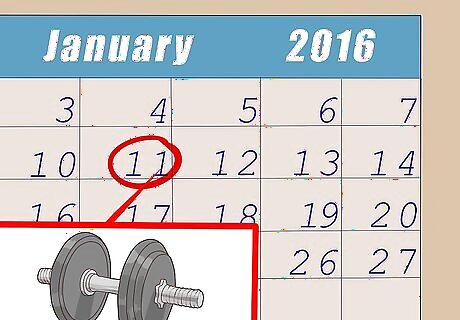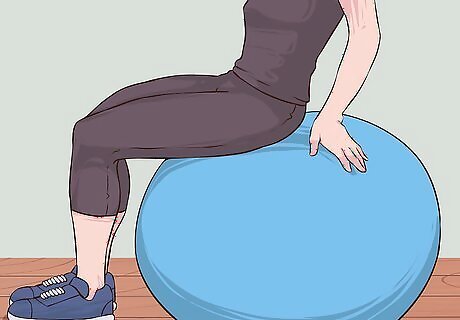
views
Designing Your Exercise Plan

Write out your goal. If you want to start a simple workout plan and stick to it, it'll be helpful to have a set of clearly written out and specific goals. This may help you tailor your workouts to meet your needs. Think about why you want to workout. Is it to lose weight? Is it to tone up your muscles? Or do you just want to feel more active? Make your goals clear, timely and specific. These characteristics help make goals more realistic for you. For example, instead of saying "I want to work out each week," say "I want to jog three times a week for 35 minutes and do two days of strength training for 20 minutes." Knowing what your goal is and what you want to get out of your workouts will help you design a simple workout plan.

Come up with a workout schedule. It can be hard to stick to a workout program if you don't know how to fit it into your busy life. Before you get started, draft up a workout schedule for your week. This may make it easier for you to stay on track with your exercise routine. Write out your schedule for the week. Schedule in each workout session that you plan on doing throughout the week. Note the time, location and what you're going to do. Seeing your week at a glance can also help you see whether or not you're meeting the recommended goals of either 150 minutes of cardio or 40 minutes of strength training. You can adjust if needed. In addition, keeping a regular weekly workout schedule and adding your exercise sessions in like an appointment may make it easier for you to stick to. Some examples of a simple week's worth of exercise could be: doing a 10 minute walk three times a day for five days of the week, plus two at-home strength training sessions; or jogging for 45 minutes three times a week plus a 60-minute strength training class; or doing two 60-minute kickboxing classes per week plus a 60-minute spin class in addition to two bodyweight sessions weekly.

Decide between the gym or home exercise. After writing out your goals and looking at your schedule, think about where you'll be doing your exercise. Do you prefer going to the gym or sticking around home? Gyms offer you a variety of benefits. You will have access to a large variety of cardio machines, weight machines and free weights and group classes. Some gyms may even have a pool or offer discounted personal training. However, gyms generally come with a monthly cost. If a gym membership isn't right for you or you do not feel comfortable going to a gym, consider working out at home or around your neighborhood. You can do a variety of workouts at home or around your home. If you have a safe neighborhood you can walk or jog. You can also do workout DVD's or online exercise programs in the comfort of your own home. If you look at your schedule and find you're strapped for time, working out from home may be a good choice.

Include cardio and strength training each week. Even if you're interested in a more simple workout routine, it's still important to include both cardio and strength training exercises. Both have a variety of health benefits and may help you reach some of your goals. Cardio is any exercise that increases your heart rate and breathing pace. It's generally associated with decreased risk of diabetes, high blood pressure, stroke, improved mood and sleep patterns and supports a healthy weight. Cardio can be anything that gets you to sweat a bit. For example: dancing, swimming, hiking, walking, stationary bikes, treadmills,stair climbers, or the elliptical machine. Aim for 150 minutes a week. Strength training offers you a different set of health benefits like improved bone density, decreased risk of osteoporosis and increased lean muscle mass. Go for 40 minutes weekly of activities like weight lifting, bodyweight exercises, or resistance tubing.

Schedule some trial runs. You've got your goals written out, you've decided where you're going to exercise and you know to include cardio and strength exercises. Now it's time to try out different exercises to see which ones fit best into your lifestyle. Take a week or two and try out different exercises, different times of day and different locations. This will help you see which things you truly enjoy and can actually fit into your lifestyle realistically. Try waking up 30 minutes early and go for a quick jog or walk. If that doesn't work well, try doing a 30 minute walk on your lunch break or driving right to the gym after work. You should also try different types of exercises. Maybe you don't enjoy running indoors, but love going for a jog outside. Try different cardio machines, try both indoor and outdoor activities and try group classes.
Staying Motivated with Exercise

Plan an exercise date. Whether you meet up with a friend or family member or make friends with others in a regular group class, having that accountability with someone else makes you more likely to show up for your workout. Working out with others is a great way to get activity but also be social and have fun. Try going to group gym classes or asking friends, family members or co-workers to meet up for a quick exercise session.

Keep your routine fresh. One reason people may drop their workouts or regular exercise routine is out of boredom. It can get old doing the same workout every week. Try switching up the types of exercise you do. Exercising doesn't always mean going for a jog. Add in a few different types of cardio that you enjoy. Even playing exercise-based video games can count! Also try to change up the location of your workouts. It's great to work out in a gym when it's cold or rainy. But hit a scenic trail or hiking trail if the weather is nice.

Make exercise fun. If you're not having fun or not enjoying exercise you might not stick with it long-term. There are a variety of activities that can count as exercise that are fun and exciting. Think about things that might not seem like traditional exercise but make you stay active. For example, plan a weekend hike or kayaking trip. You can also play for exercise. If you enjoy playing sports like soccer, basketball or softball, sign up for a work team or local intramural team.

Plan rewards for yourself. Setting up rewards for yourself when you meet goals or stick with them long-term may be able to keep you motivated to exercise. Think about things that would be enticing to you. Maybe a new exercise shirt, new songs for your jogging playlist or a new set of walking shoes. Also consider internal rewards. After you exercise think about how good you feel and the health benefits that you reap by exercising regularly.




















Comments
0 comment